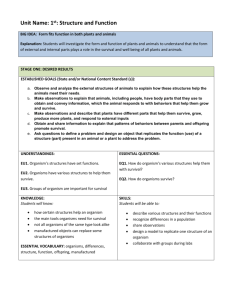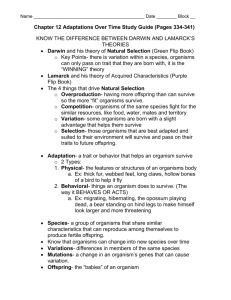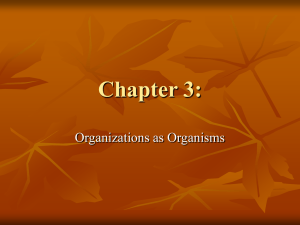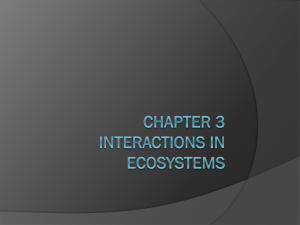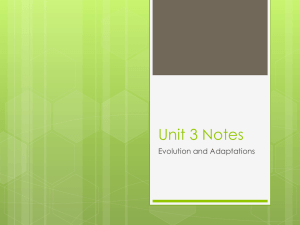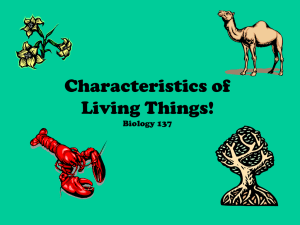Review Packet 4 Answers 3.05 Examine the development of the
advertisement
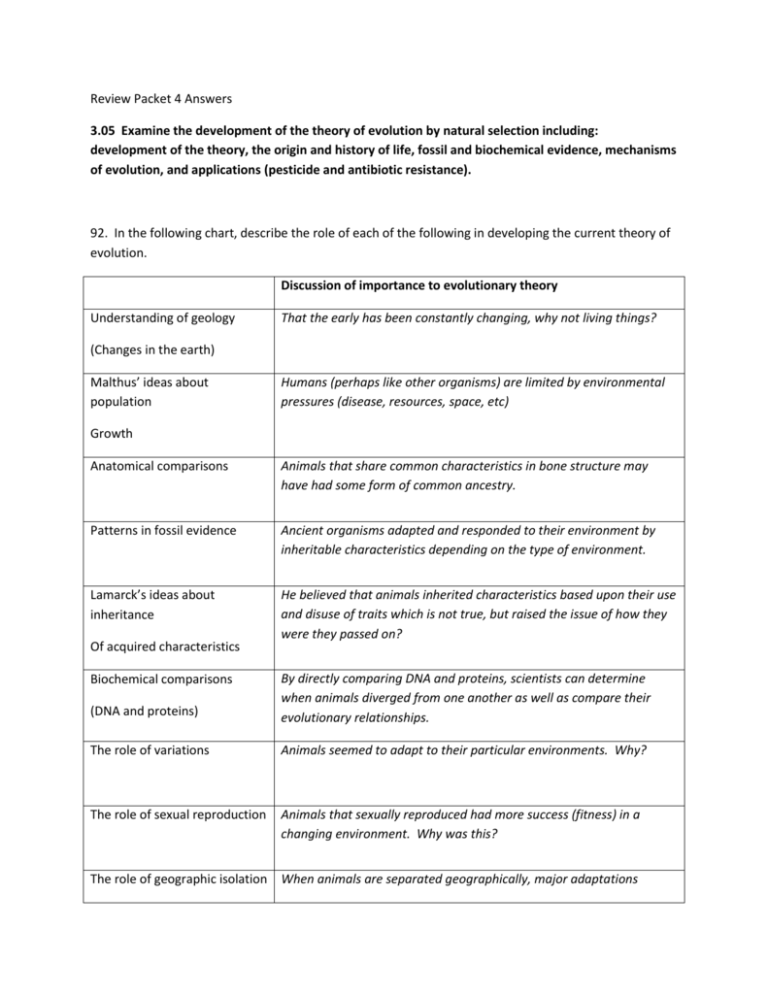
Review Packet 4 Answers 3.05 Examine the development of the theory of evolution by natural selection including: development of the theory, the origin and history of life, fossil and biochemical evidence, mechanisms of evolution, and applications (pesticide and antibiotic resistance). 92. In the following chart, describe the role of each of the following in developing the current theory of evolution. Discussion of importance to evolutionary theory Understanding of geology That the early has been constantly changing, why not living things? (Changes in the earth) Malthus’ ideas about population Humans (perhaps like other organisms) are limited by environmental pressures (disease, resources, space, etc) Growth Anatomical comparisons Animals that share common characteristics in bone structure may have had some form of common ancestry. Patterns in fossil evidence Ancient organisms adapted and responded to their environment by inheritable characteristics depending on the type of environment. Lamarck’s ideas about inheritance He believed that animals inherited characteristics based upon their use and disuse of traits which is not true, but raised the issue of how they were they passed on? Of acquired characteristics (DNA and proteins) By directly comparing DNA and proteins, scientists can determine when animals diverged from one another as well as compare their evolutionary relationships. The role of variations Animals seemed to adapt to their particular environments. Why? The role of sexual reproduction Animals that sexually reproduced had more success (fitness) in a changing environment. Why was this? Biochemical comparisons The role of geographic isolation When animals are separated geographically, major adaptations occurred. Why? The importance of the environment A constant theme in whether or not animals survived or went extinct was their natural environment. How did this shape how animals survived then and today? 93. What is a vestigial structure? Name a few in humans. A structure that is no longer useful to an organism, but may have been used by ancestors. Vestigial structures in humans include the coccyx (tail bone), ear muscles, appendix, and goose bumps from getting scared. 94. What are some of the ideas on the origins of life? (A.k.a. where and when did it form?) Life likely formed in the Earth’s oceans where it was constant and safe from the toxic, oxygen deprived atmosphere and harsh land conditions. As cyanobacteria produced oxygen and the climate changed that the oceans dried up (not totally!), animals and plants began to move the land environment and develop complexity from simple carbon molecules to amino acids, protocells and cells. 95. Discuss the steps in Darwin’s theory of evolution by natural selection. (Chapter 15) 1) Populations of organisms have many genetic variations. Where do these come from? Inherited genes seen fit by those best suited to the environment who could find food and a mate to pass those on to their offspring. 2) Organisms could reproduce exponentially but they don’t. Why not? What are they restricted by? No, they are restricted by food availability, space and mate selections. The best suited to the environment will survive & reproduce. 3) What are adaptations? Any inherited characteristic that increases an organism’s chance of survival. 4) Some adaptations have better survival value in certain environments. What does this mean? Some adaptations (based upon genotypic mutations) are not favorable for that particular environment. They are not selected for and that particular organism dies and does not pass on that particular adaptation to their offspring. 5) What does it mean to be “fit” to an environment? The ability of an individual to survive and reproduce in their particular environment. 6) The next population will have a high frequency of the genes that have been selected for. Why will the frequency of selected genes increase? Those who are fit will be the only ones to survive and reproduce passing on those genes. 7) What is Darwin’s theory of Natural Selection? What is Artificial Selection? In natural selection, only the fittest will survive to produce offspring for the next generation (survival of the fittest.) In artificial selection, humans select organisms for desired traits and ensure breeding (plus survival) so those traits is present in their offspring. Such as particular dog breeds that could never survive in the natural environment. 8) When this process continues over millions of years, it can lead to speciation. What is speciation? When members of a species evolve they split and become reproductively isolated from one another. This creates two new species. 96. Compare and contrast convergent and divergent evolution. Convergent evolution is when two generally unrelated species in different areas adopt similar adaptations based upon a common environment. Divergent evolution is when animals diverge from each other then they geographically adopt different areas and must take on different characteristics as adaptations in order to survive, becoming more different than one another. 97. Sketch or describe the following: Stabilizing Selection, Directional Selection and Disruptive Selection. Stabilizing Selection – When individuals at the phenotypic extremes are selected against and those in the middle are selected for. Creates a species more uniform, towards the average. (Bell Shaped Curve) Directional Selection – When individuals at one phenotypic extreme are selected for and those in the middle or other extreme are selected against. Creates one type of species slanted in that direction. (Directional Curve) Disruptive Selection – When individuals at each phenotypic extreme are selected for and those in the middle are selected against. Creates two new species (speciation) to form. (Disruptive Shaped Curve) 98. What is adaptive radiation? How did the finches of the Galapagos adapt to their environment? Adaptive radiation is a type of divergent evolution where groups based upon new environments adapt differently creating new species. Darwin’s finches adapted according to their food source and was reflected in their type of beak. 99. Describe how a population of bacteria can become resistant to an antibiotic (or an insect to a pesticide) using the steps listed above. How is this a direct way to observe evolution? Bacteria that have natural mutations to survive a particular insect or pesticide have new space and resources to survive and reproduce creating a new generation resistant to that particular obstacle. 100. What happens when pesticides and antibiotics are used and how does it relate to evolution? When one particular antibiotic is used frequently, populations evolve (see question 99) a natural immunity to it. This is the exact theory of Darwin’s survival of the fittest. 101. What are the differences between abiogenesis (spontaneous generation) and biogenesis? In abiogenesis life can arise from nothing, even air. In biogenesis, life must arise from other living life. 102. What did Louis Pasteur contribute to our understanding of the origins of life? Louis Pasteur described through his curved flask experiment that life cannot come simply from air but through other living things, such as molecules that we cannot see (microorganisms). 103. Why did Miller and Urey put those particular gases into their experiment? the early Earth’s atmosphere where life would have likely started. They were found in 104. What type of organic molecules did they find? Amino acids 105. What is the significance of their experiments? Amino acids are the monomers or building blocks of proteins that make up organisms or life. 106. Most hypotheses state that prokaryotic anaerobes probably evolved first. Why? Because there was no oxygen in the early Earth’s atmosphere. 107. The hypotheses then suggest that prokaryotic autotrophs probably evolved? Why? They were the ones (i.e. cyanobacteria) that produced the oxygen that is found in our atmosphere today. 108. What gas would enter the atmosphere as a result of these autotrophs appearing. OXYGEN! 109. Then prokaryotic aerobic heterotrophs could evolve. What can these cells do that others before them cannot? Synthesize organic materials into energy. Before then there was only the SUN to use energy. 110. What is the hypothesis explaining how eukaryotic cells evolved? Endosymbiont theory (Lynn Margulis) 4.04 Analyze and explain the interactive role of internal and external factors in health and disease (genetics, immune response, nutrition, parasites, and toxins) 25. Explain the relationship between sickle cell anemia and malaria. In a hertozygous form the sickle cell gene provides resistance to malaria 26. Explain the relationship between lung and mouth cancer and tobacco use. The tobacco is a carcinogen that can lead to uncontrolled cell growth 27. Explain the relationship between skin cancer, vitamin D, folic acid and sun exposure. Sun burns destoy folic acid in the skin which helps prevent cancer. The skin needs sun to make vitamin D 28. Explain the relationship between diabetes, diet/exercise, and genetics. Potential for diabetes can be genetic and good diet and exercise can help maintain health blood glucose levels. TWO TYPES OF DIABETES. TYPEII DIABETES HAS A GREATER GENETIC, DIET AND EXERCISE COMPONENT. TYPE I DIABETES (JUVENILE) IS AN AUTOIMMUNE DISEASE OF UNKNOWN CAUSES WHERE THE PART OF THE PANCREAS THAT MAKES INSULIN IS DESTROYED. 29. Explain the relationship between PKU and diet. A person with PKU must be on a low phenylalanine diet to make up for the lack of enzyme production that breaksdown phenylalanine. THIS IS AN INHERITED GENETIC DISEASE. Immune Response (Chapter 40) 30. What are some of the non-specific first lines of defense? Mucus, Skin, 31. What are some of the non-specific second lines of defense? __inflammatory response, white blood cells 32. What is Humoral Immunity? What type of cell does it involve? What do they produce? B cells, antibodies Immunity against antigens and pathogens in the body fluids. B cells. 33. What do B cells produce? Plasma cells and memory B cells 34. What is happening at letter C? Antibodies are attacking the pathogens 35. What is the function of helper T-cells? They activate killer T cells and produce memory T cells 36. What is the function of killer T-cells? Track down and kill pathogens 37. What is the function of suppressor T-cells? Shut down killer T cells when the job is done 38. What kind of cells are produced at letter D that keep you from becoming re-infected? (Secondary infection?) Memory B Cells 39. What is the difference between active immunity and passive immunity? Active is the body's response to vaccines. Passive is the injection of other animals antibodies 40. Explain what vaccines do to the immune system. They induce the body's development of antibodies 41. Are antibiotics used against viruses? What is used against viruses? No, they only work against bacteria. You need anti-viral meds against viruses. Health and Nutrition 42. What type of diet contributes to optimal health? (High in what and Low in what?) High in fiber/protein, low in fat. Balanced diet. High-carbs and fruits and vegetables Low- fats oils and sweets 43. What type of diet contributes to obesity? Diabetes? (Page 1008) High in sugar (see question 42.) high in complex carbohydrates and low in saturated fats. 44. What type of diet contributes to malnutrition? A lack of vitamins and minerals 45. What happens when someone is deficient in Vitamin C? Scurvy Vitamin D? Rickets A? Vitamin 46. What are some of the concerns over skin cancer, folic acid and sun exposure? (Pages 974) same as 27 47. What are some of the concerns over lung and mouth cancer from tobacco use? (Pages 962) same as 28 Parasites (Malaria) 48. Describe the life cycle of the malarial parasite. (Page 503) What is the vector? treatments? Mosquitoes and mosquitoes control What are the symptoms? severe chills and fever Environmental Toxins 49. Explain the effects on human health of: What are the drugs, NO vaccine KNOWN, Lead: _increased blood pressure, anemia, brain and kidney damage, LOW IQ Mercury: brain damage, blindness, seizures 4.05 Analyze the broad patterns of animal behavior as adaptations to the environment. 50. What is a stimulus? What is a response? (Page 871) any kind of signal that carries information and can be detected. Response – a reaction to a stimulus 51. Why is it important that organisms are able to respond to their environment and surroundings? Allows for interaction with the environment and increased fittness. 52. What are some ways that animals communicate? (Pages 881-882) visual signals, chemical signals, sound signals, language. 53. Compare and contrast classical conditioning and operant conditioning. (Pages 874-875) classical is based on punishment and reward - Operant is based on repeated behavior. 54. What is habituation? Why is it good for the animal and evolution as a whole? The process by which animals decrease or stop response to repetitive stimulus that niether rewards or harms. Decreases use of unnecessary expense of energy. 55. What is imprinting? Why is this important? (Page 876) recognizing and following the first thing a baby sees to move. It keeps young animals close to their mothers 56. Describe insight learning and explain which type of species has this kind of behavior. (Page 875) Reasoning. The ability to apply something learned to a new situation. Comman among humans and other primates. 57. Complete the following Chart of Animal Behavior. (Chapter 34) Type of Behavior Explanation of Behavior Survival Value of Behavior Suckling This is when an organism is born knowing how to ‘suckle’ or obtain milk from its mother. Allows for newborns to get nutrition Insects moving away or toward light Positive Phototaxis and Negative Feeding and protection Migration This is when organisms move from one place to another periodically, generally in response to temperature or food availability. Maintaining food source/ GOOD BREEDING Estivation This is when an organism goes dormant for a long period of time to escape hot temperatures. Surviving extreme conditions (hot) Hibernation This is when an organism goes dormant for a long period of time to escape cold temperatures. Surviving extreme conditions (cold) Habituation This is when an organism learns to ignore a stimulus because it is repetitive and is not providing any valuable information. Conservation of energy Imprinting This instinctive behavior is when some baby bird species will follow the first moving object they see, usually the mother. Keeps newborn close to mother for food and protection Classical conditioning Any time an animal learns to make a Allows animal to make beneficial choices connection between a certain behavior and a given reward or punishment. Trial and error When faced with two choices, an organism can learn to choose the option with the best reward. same Communication using pheromones Chemical signals Increases fitness through mating Courtship dances When an individual performs some ritual – either sounds, visual display, pheramones, same Phototaxis etc. – in order to attract a mate. Territoriality This is when an organism will defend or mark a defined living space. 58. Which of the above behaviors are innate (or instinct)? All but those listed in 59 59. Which of the above behaviors are learned? Classical conditioningHABITUATION and trial and error 60. Which of the above behaviors are social? Courtship and territoriality AND SOME MIGRATION Decreases competition
